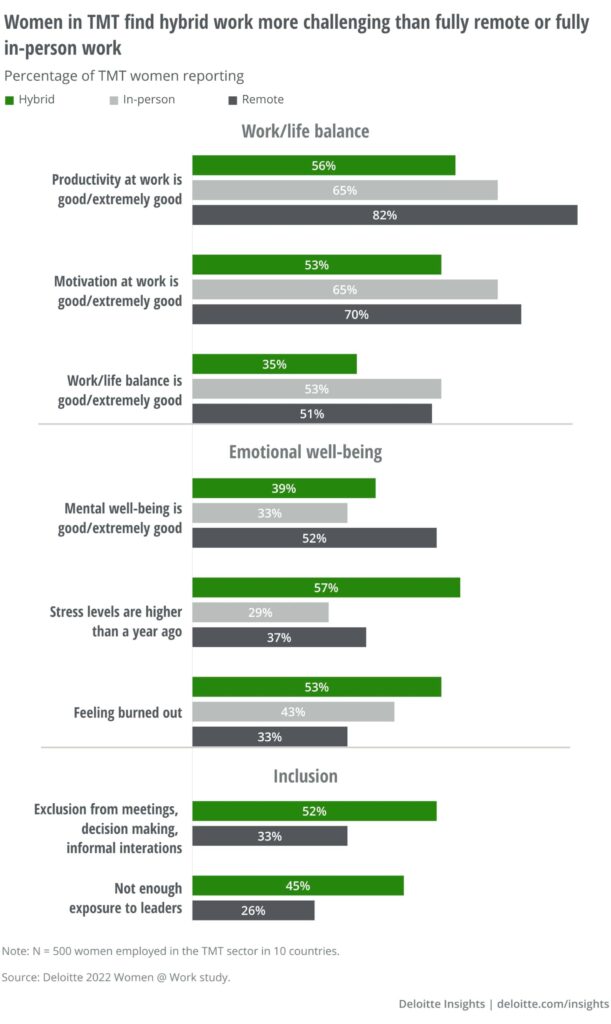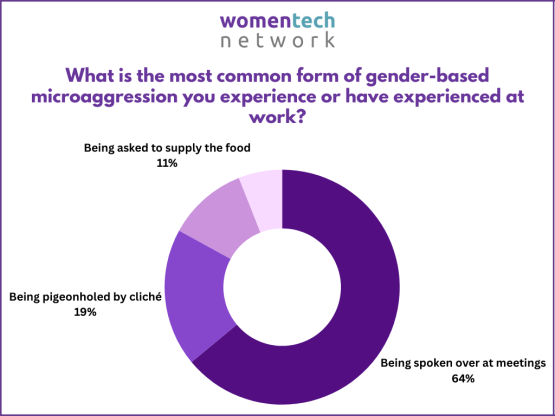Women in Tech Statistics – Gender, Remote Work & Pay Gap

Despite significant advances, women in tech and other fields continue to face underrepresentation in the global labor market. Studies show that less than half (47.7%) of working-age women participate in the workforce worldwide. In some countries, this figure is even lower – meaning there is only one employed woman for every two employed men.
This gap represents a massive pool of untapped talent and economic potential. Studies consistently demonstrate that increasing women’s participation in the workforce drives economic growth and boosts productivity. Companies that embrace gender diversity also outperform those that do not.
Key Takeaways:
- Women constitute less than a third of the global tech workforce, revealing a significant representation gap.
- Barriers to female advancement in tech include gender bias, lack of affordable childcare, and insufficient mentorship access.
- Companies with greater gender diversity in their teams show superior performance and innovation.
- The economic benefits of increasing women’s workforce participation include higher productivity and growth.
- Leadership roles and senior positions in tech remain predominantly male, highlighting the need for systemic change.
- Remote work offers benefits but also presents challenges like increased stress and feelings of exclusion for women.
- Addressing the gender gap requires actionable commitments from companies, such as enforcing pay equity, enhancing flexibility, and fostering inclusive cultures.
So what’s holding women back from reaching their full economic potential?
A few key factors:
- Gender discrimination and bias in hiring, promotions, and pay
- Lack of affordable childcare options and family leave policies
- Inadequate access to education, finance, and skills training
- Cultural norms and expectations around women’s roles
The good news? More and more countries are waking up to the benefits of empowering women economically.
Emerging economies have led the way, with female labor force participation rates steadily rising over the past decade. However, progress has lagged in advanced economies due to varying economic policies and incentives.
As business leaders and policymakers, we must prioritize removing barriers and creating ecosystems that enable women to thrive professionally. This means:
- Promoting gender parity in pay, leadership, and opportunities
- Investing in childcare infrastructure and family-friendly policies
- Ensuring access to education, finance, mentorship, and upskilling
- Shifting cultural mindsets through awareness and advocacy
Tapping into the full potential of women isn’t just good for business – it’s crucial for driving innovation, economic competitiveness, and societal progress. It’s time to double down on efforts that empower women to bring their talents to the global workforce.
Women in the Tech and STEM Fields in the U.S.
Despite remarkable advancements, women remain significantly underrepresented in technology and STEM fields across the United States and globally. The numbers speak volumes:
- According to the World Bank, women make up less than a third of the world’s tech workforce.
- In the U.S., only 25% of the STEM labor force is female, with women holding just 35% of tech jobs as of 2023.
At tech giants like Amazon, Facebook, Apple, Google, and Microsoft, women comprise only:
| Amazon | 45% |
| 37% | |
| Apple | 34% |
| 33% | |
| Microsoft | 33.1% |
Gender disparity is even starker in leadership roles at these companies, with women accounting for just:
- 29% at Amazon
- 34% at Facebook
- 31% at Apple
- 28% at Google
- 26% at Microsoft
Underrepresentation isn’t just a fairness issue – it’s an economic one too. Studies show that gender diversity boosts innovation, problem-solving, and financial performance. Companies that fail to tap into the female talent pool leave significant value on the table.
What’s causing this gap? A combination of factors, including:
- Lack of female role models and mentors in STEM
- Ingrained societal biases and stereotypes from an early age
- Inhospitable workplace cultures and a lack of family-friendly policies
- Financial and educational barriers to entering STEM careers
The Tech Employment Gender Gap
The tech industry has made strides in promoting gender diversity over the past few decades. U.S. Census data shows that the percentage of women in STEM roles has grown from a mere 8% in 1970 to 28% by 2019.
Yet, despite this progress, a significant gender gap persists – especially in the highest echelons of the tech world.
In 2023, women represented only 29% to 45% of the workforce at leading tech giants like Google, Apple, Facebook, Amazon, and Microsoft (GAFAM). On average, just 31% of GAFAM employees are female.
Even more concerning?
This underrepresentation compounds as careers advance:
- Female applicants comprise a higher percentage of junior tech job candidate pools
- But their representation drops for mid-level roles (4-10 years experience)
- And drops again for senior-level positions across various functions
Gender disparity is particularly acute in certain domains:
- Software engineering sees around 25% fewer female applicants from junior to mid-level roles
- Fields like ERP, UI/UX design, and cross-functional roles exhibit an even starker senior-level drop-off
This progressive attrition of female talent up the ranks points to systemic barriers and biases that pervade the tech industry, including:
- Lack of sponsorship, mentorship, and growth opportunities
- Inhospitable workplace cultures and a lack of work-life integration
- Unconscious biases in hiring, promotions, and pay decisions
- Insufficient efforts to attract, retain, and develop female leaders
Statistics on Remote Work Gap

The pandemic in 2019 ushered in a seismic shift towards remote and hybrid work models across industries, but its impact has been particularly pronounced in the tech sector.
As companies grapple with optimizing these new paradigms, Deloitte’s latest data reveals some striking trends around the experiences of women in tech:
The Hybrid Majority
- In 2022-2023, most women working in tech, media, and telecom (TMT) operated in a hybrid setup (51%)
- Over a third (39%) worked fully remote
The Remote Work Upside
When it comes to key factors like work-life balance, productivity, motivation, and emotional well-being, fully remote employees often come out on top:
- 65% of remote workers rated their work-life balance as good/excellent (vs. 56% hybrid, 82% in-person)
- 65% were satisfied with their productivity levels (vs. 56% hybrid, 82% in-person)
- 65% rated their motivation as good/extremely good (vs. 53% hybrid, 70% in-person)
- 52% gave positive ratings for emotional well-being (vs. 39% hybrid, 33% in-person)
But There’s a Flip Side
However, remote work also brought its own set of challenges, particularly around:
- Stress: 37% of remote workers saw increased stress (vs. 29% hybrid, 57% in-person)
- Burnout: 43% experienced burnout (vs. 53% hybrid, 33% in-person)
- Inclusion: 33% felt excluded from key aspects of work (vs. 52% hybrid)
- Leader Access: 26% lacked enough exposure to leaders (vs. 45% hybrid)
These findings underscore that while remote work may offer some benefits for women in tech, it is far from a panacea when it comes to holistic well-being and career development.
As employers continue refining their future-of-work strategies, key priorities should include:
- Fostering inclusion and belonging in virtual environments
- Facilitating mentorship and sponsorship opportunities
- Proactively combating remote work’s unique stressors
- Offering robust well-being resources and flexibility
- Creating intentional touchpoints for leader engagement
By thoughtfully addressing remote work’s tradeoffs, companies can better position female tech talent for success and growth – regardless of work modality.
Workplace Culture Issues Holding Women in Tech Back

As the tech industry continues to grapple with persistent gender imbalances, one factor stands out as a make-or-break factor for women leaders: workplace culture and flexibility.
WomenTech Network survey found that a staggering 48% of female executives cited flexibility as one of their top three considerations when evaluating a company – far outpacing their male counterparts at 34%.
This prioritization isn’t just about work-life balance. It reflects a deeper need for environments that embrace diversity, equity, and inclusion (DE&I).
Women are 1.5 times more likely than men to have changed jobs specifically to find a workplace dedicated to DE&I values.
The data reveals that many companies still have a long way to go in fostering truly inclusive cultures for their female employees, particularly in tech roles:
- 64% of women surveyed report being spoken over in meetings
- 19% feel pigeonholed by gender stereotypes in various situations
- 11% have been asked to “supply food” for meetings
- Gendered language and being tasked with note-taking are described as “the usual” microaggressions
While remote and hybrid work models provide some temporary insulation from bias, they are far from a panacea. Relying solely on virtual interaction avoids the deeper systemic issues that need to be addressed head-on.
Winning the war for female tech talent – and the innovation advantages diversity provides – demands a multifaceted approach:
- Consciously combating unconscious biases through training
- Fostering psychologically safe, inclusive team cultures
- Ensuring equal growth, advancement, and compensation opportunities
- Celebrating and empowering diverse leadership and role models
- Embracing family-friendly policies and work flexibility
The tech world’s most forward-thinking leaders recognize that homogeneity is the enemy of innovation. It’s time to tear down the cultural barriers and systemic biases holding women back.
Women in Tech: C-Suite
While corporate America has made incremental progress on gender diversity, stark imbalances persist – especially at the highest echelons of leadership and pay. In the tech sector, the data highlights glaring disparities:
- Only 25% of C-suite leaders across corporate America are women
- A mere 5% represent racial minority females
- This “broken rung” makes achieving true gender parity extremely difficult
Even when women ascend to senior roles in tech, many face persistent “bro culture” challenges:
- 72% of women in tech report experiencing this prevalent form of discrimination
- 63% in engineering and IT roles have encountered entrenched bro culture behaviors
Woman in Tech: Pay Gap
Pay inequity compounds the challenges women in tech face:
- Men in STEM jobs earn nearly $15,000 more per year on average ($85,000 vs $60,828)
- The gap is even wider for Latina and Afro-American women, earning around $52,000 annually
- A U.S. study found a 1.6% gender wage gap in favor of men
- Women accepted 95 cents for every $1 men made when working remotely
The drivers behind this pay divide are multifaceted, including:
- Racial bias plays a major role for women of color
- Hispanic women and African Americans expect to make just 91 cents per $1 earned by white men
- Unconscious biases impact hiring, promotions, and compensation decisions
- Lack of pay transparency and enforceable equity policies
The tech industry needs to close its gender leadership and pay gaps – it’s an economic imperative. Companies that fail to unleash the full potential of their female workforce are leaving innovation, performance, and growth on the table.
To bend the arc, leaders must take decisive action:
- Set measurable DE&I goals and hold teams accountable
- Conduct pay equity audits and enforce parity policies
- Expand sponsorship and career mobility programs for women
- Cultivate inclusive cultures that combat bias and discrimination
- Offer robust work-life integration and family-friendly benefits
The time is now to shatter tech’s glass ceilings and pay disparities.
After all, a rising tide of equity lifts all boats.
Sources:
WomenTech
Techopedia
Deloitte
PWC
Census
You may also like: List of Must-Have Soft Skills for Software Engineers


